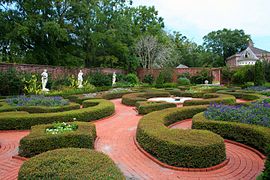Formal garden
A formal garden is a clearly structured garden that has geometric shapes and is usually symmetrical . It has its origins in walled gardens in the desert regions of the Near East and is reflected in the Persian Gardens of Iran and the monastery gardens of the late Middle Ages . It finds its continuation in the Renaissance Italian gardens and culminates in the French gardens of the Baroque . Through its design, the garden gives the viewer the impression of well-designed order and clarity. In garden art , it is seen as the opposite of the landscape garden modeled on nature , which came into fashion in the 18th century.
features
A typical feature of a formal garden is the axial, symmetrical arrangement of paths and beds. Both elements are normally of borders, for example by low book hedges or flower borders. The garden is usually surrounded by “green walls” such as overgrown walls, fences or cut hedges. The thus created space is garden again by hedges, trellises and trellises ( trellises divided). The surfaces of the individual parts of the garden created in this way are structured by low elements, the clarity and straight lines of which exude a certain simplicity. The center of the garden is often emphasized by a round, oval or square.
Materials such as bricks , bluestone and paving stones are used to cover the sidewalks . Alternatively, the paths can be strewn with light gravel or colored glass gravel . Their straight lines form visual axes, at the ends of which there are often eye- catchers such as sculptures , ornamental basins, fountains , planters, vases or seating.
Other eye-catchers can be ornamental design elements such as decorative beds with intertwined patterns (so-called knot beds) or with complicated geometric arrangements of plants. However, such formal gardens not only partially give up their restrained, simple design, they also lose the advantage of being generally easy to care for. Most of the plants in a formal garden can get by with just one cut per year. This is often used for topiary , that is, evergreen trees such as boxwood, yew , holly or pine are brought into geometric shapes such as spheres , pyramids , cones or even animal and fantasy shapes . In larger formal gardens there is often a shaped hedge maze with arches, hidden resting places, and dead ends.
For the planting of the beds, low perennials and flowers that visually match each other are usually chosen. When choosing, it is not their flowers that are important, but the shape and color effect of their foliage, which is why ornamental perennials are often chosen for this. If lawn is used in a formal garden, it is only in the form of cropped ornamental lawn.
- Examples
The Sabatini gardens of the Palacio Real in Madrid
The formal gardens of Villandry Castle
The formal garden of Hampton Court Palace
literature
- Mark Laird, Hugh Palmer: The Formal Garden. Traditions of Art and Nature. Thames and Hudson, London 1992, ISBN 0-500-01542-2 .
- Günter Mader, Laila Neubert-Mader: The English Formal Garden. Five Centuries of Design. Aurum, London 1997, ISBN 1-85410-473-X .
- Herta Simon: Designing gardens. How garden wishes become dream gardens. Gräfe and Unzer, Munich 2013, ISBN 978-3-8338-2108-0 , pp. 21-22 ( digitized version ).
- Herta Simon, Marion Nickig, Jürgen Becker: The large GU garden book. The standard work for every garden lover. Gräfe and Unzer, Munich 2016, ISBN 978-3-8338-5392-0 , pp. 132-133 ( digitized version ).
- Allen S. Weiss: Mirrors of Infinity. The French Formal Garden and 17th-Century Metaphysics. Princeton Architectural Press, New York 1995, ISBN 1-56898-050-7 .
Web links
Individual evidence
- ↑ Christina Waldeyer: Homo hortulanus. The attribution of meaning in private home garden designs. Springer, Wiesbaden 2016, ISBN 978-3-658-13453-2 , p. 185.
- ^ H. Simon et al .: The large GU garden book. 2016, p. 121.
- ↑ a b c H. Simon et al .: The large GU garden book. 2016, p. 132.
- ^ H. Simon: Shaping gardens. 2013, p. 22.
- ↑ a b deavita.com , accessed on September 13, 2016.
- ↑ a b Formal Garden on Wohnen.de , accessed on September 13, 2016.





